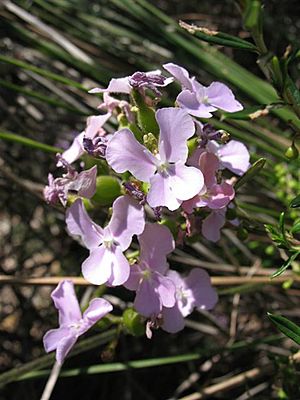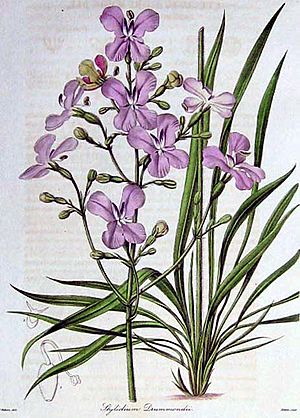Stylidium affine facts for kids
Quick facts for kids Stylidium affine |
|
|---|---|
 |
|
| Scientific classification | |
| Genus: |
Stylidium
|
| Species: |
affine
|
| Synonyms | |
|
|
Stylidium affine is a special kind of plant that grows only in Western Australia. It belongs to a group of plants called Stylidium, also known as triggerplants. These plants are famous for their unique way of spreading pollen!
What Does Stylidium affine Look Like?
Stylidium affine is a plant that lives for many years. It has long, thin leaves that look like spear tips. These leaves are about 12 to 30 centimeters (5 to 12 inches) long. They grow in groups of 2 to 4, coming out from a papery base. This makes the plant look like a small tuft of leaves.
The plant's flowers grow on tall stems called flower stalks. These stalks are usually 20 to 30 centimeters (8 to 12 inches) tall. They have many small flowers that are rose pink to purple. Each flower has two main petals that are about 8 to 11 millimeters long. There are also four small, white, wing-like parts inside the flower. Stylidium affine usually blooms in October.
Where Does Stylidium affine Grow?
Stylidium affine is found in Western Australia. It likes to grow in reddish-brown soils, often near large rocks called granite outcrops. You can often find it in open woodlands, especially where Eucalyptus wandoo trees grow.
This plant lives in an area stretching from east of Gingin down to Kojonup and west to Dunsborough. In the southern parts of its home, it grows with Eucalyptus wandoo or Corymbia calophylla trees. It grows in a different area than its close relative, S. caricifolium.
How Stylidium affine Got Its Name
The plant we call S. affine today was first described in 1841 by a botanist named Robert Graham. He called it Stylidium drummondii. He got seeds from James Drummond, who was exploring Western Australia.
Later, in 1845, another botanist named Otto Wilhelm Sonder gave the plant the name Stylidium affine. Over the years, most scientists started using the name S. affine.
Recently, a scientist named Juliet Wege found that the first name, S. drummondii, was actually given earlier. This meant that, by strict rules, S. drummondii should be the correct name. However, because almost everyone had been using S. affine for a very long time, she suggested that the name S. affine should be officially "saved" or "conserved." This helps keep plant names stable and avoids confusion. Scientists voted to recommend keeping S. affine as the official name.
In the past, some people thought S. affine was just a type of S. caricifolium. But later studies showed that S. affine is different enough to be its own species, especially because of its leaves and how many chromosomes it has.


